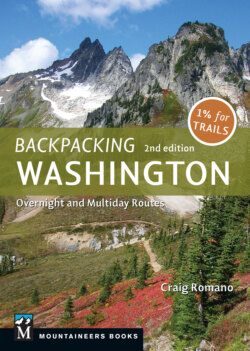Читать книгу Backpacking Washington - Craig Romano - Страница 13
CAMPING
ОглавлениеWhen choosing a place to set up camp for the night, always use established sites if available. If there are none, stay well away (at least 200 feet) from lakeshores and creekbeds. Meadows, too, should be avoided. If you are camping in an area with meadows, seek sheltered, wooded sites at the meadows’ edge. Never camp in areas closed for rehabilitation, and always adhere to rules and regulations (particularly those related to permits and group size). In some lessvisited areas, you are free to camp almost anywhere you please (though always follow Leave No Trace principles). Other areas are strictly regulated, requiring reservations and assigned camping sites.
In general, most destinations on national forest land require at most a self-issued permit that is available at the trailhead. The exception is the Enchantment Lakes in the Okanogan-Wenatchee National Forest, which requires a complicated Enchantment Permit for overnight visits from May 15 to October 31 (see Hike 46). Visit the forest website for details on how to acquire one of these limited permits.
Washington’s three national parks all require permits for backcountry camping, and each park issues them differently.
Mount Rainier National Park: During summer months, obtain permits at any ranger station in the park during open hours. Permits are available for a flat fee and are issued the day of your trip or up to one day before. Reservations are not required but are highly recommended if you plan to visit popular places during the summer and on weekends. Seventy percent of Mount Rainier’s wilderness camping permits are available through the reservation system and can be secured several months in advance. There is a fee for making a reservation. Visit www.nps.gov/mora for details.
Morning coffee at Camp Belview on Six Ridge (Trip 13)
North Cascades National Park: Permits are required year-round for all backcountry camping in the park, including for the Ross Lake and Lake Chelan National Recreation Areas managed by the park. Permits are issued according to a site or a cross-country zone, and there is no cost. They are available in person on the first day of your trip or up to one day before at the Wilderness Information Center in Marblemount. If you won’t be passing through Marblemount, obtain your permit at the closest ranger station en route to your destination trailhead. Reservations (fee) can be made for up to 60 percent of the complex’s sites. Details on ranger stations, hours of operation, reservations, and other permit information can be found at www.nps.gov/noca/planyourvisit/permits.htm.
Olympic National Park: Backcountry camping permits are required and involve a fee, payable in advance or on the first day of your trip, that includes a per person (children fifteen and younger are free) per night charge and a flat permit fee. Annual passes are also available for frequent wilderness visitors (covers nightly fee but not permit and reservation fees). Popular areas such as the High Divide and Cape Alava require reservations, and permits are limited. Half of the permits in some other areas are reservable. Permits may be picked up at the Wilderness Information Center in Port Angeles as well as at other ranger stations within the park. In some instances, permits can be filled out at the trailhead, where you’ll find envelopes with printed instructions. Visit www.nps.gov/olym for details.
Backcountry permits have their pluses and minuses. They allow land managers to limit numbers, reducing pressure in fragile areas and enabling you to have a better wilderness experience. On the other hand, they don’t allow for spontaneity and can really frustrate you, limiting where and when you can camp. Of Washington’s three national parks, I find Olympic’s system the most convenient.
